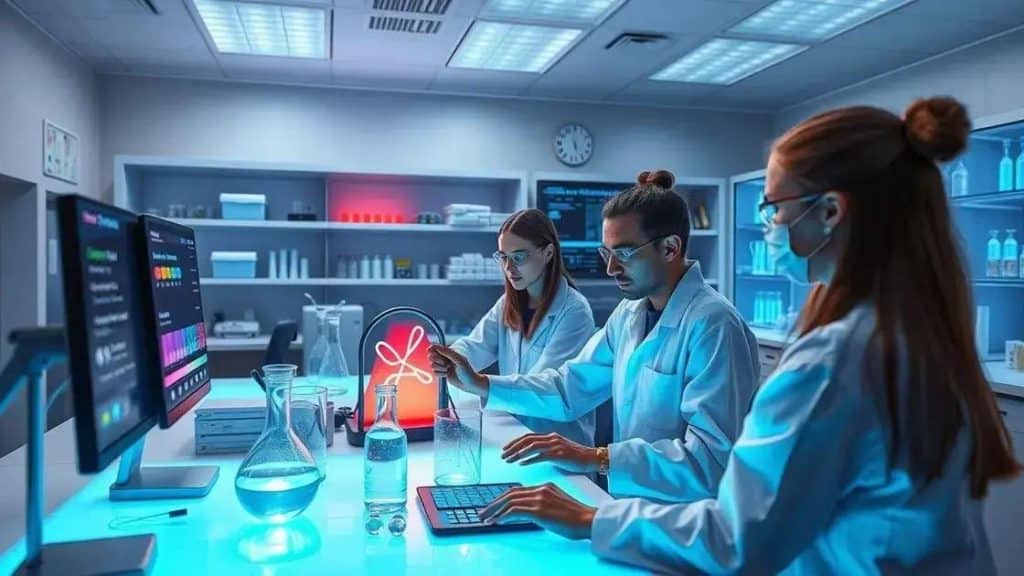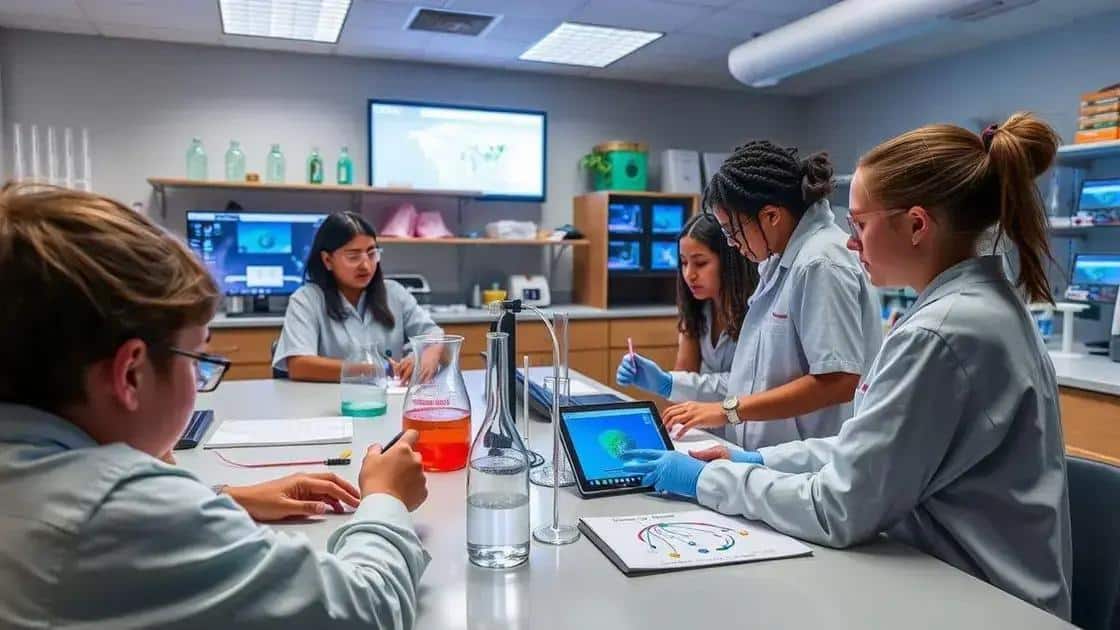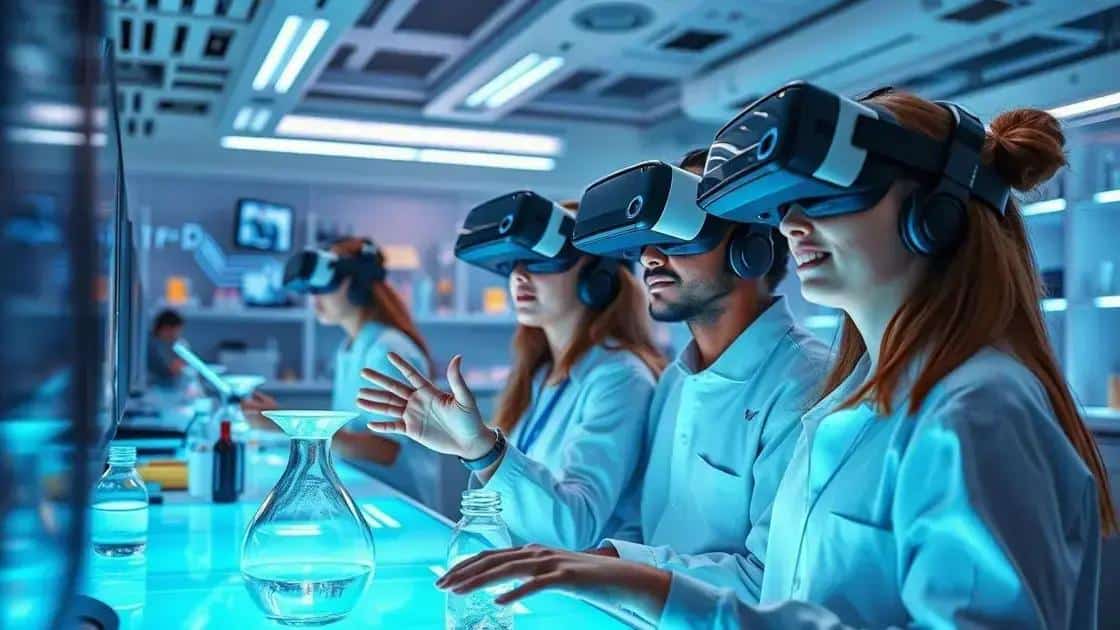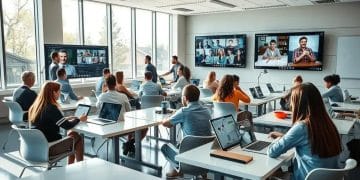Insights on virtual lab simulations: transforming education

Virtual lab simulations provide an interactive and safe learning environment, enhancing student engagement by allowing hands-on practice and personalized learning through advanced technologies like AI and immersive experiences.
Insights on virtual lab simulations have become essential in modern education, transforming traditional methods into immersive experiences. Have you ever wondered how these simulations can enhance your learning journey? Let’s explore this innovative approach.
Understanding virtual lab simulations
Understanding virtual lab simulations is vital for grasping their role in modern education. These simulations offer students a glimpse into real-world science and engineering concepts without the need for a physical lab space.
What are virtual lab simulations?
Virtual lab simulations are interactive online platforms that allow students to conduct experiments in a simulated environment. They provide the benefits of traditional labs, such as experimentation and problem-solving, but in a safer and more flexible setting. Students can practice various scenarios and techniques with no risk of injury or damage.
Key features of virtual lab simulations
- Interactivity: Students can manipulate variables and see real-time results.
- Accessibility: Labs can be accessed anytime, making learning more adaptable.
- Cost-effective: There are no lab fees or equipment costs.
- Realistic experience: High-quality graphics and sound enhance the learning experience.
This innovative approach allows for personalized learning. Students can progress at their own pace and revisit complex concepts as needed. Furthermore, teachers can track progress and assess understanding through built-in assessments that ensure mastery of critical skills.
Applications in education
Many educational institutions are incorporating virtual lab simulations into their curricula. These tools are especially beneficial for remote learning environments, where access to traditional labs may be limited. The flexibility of virtual labs enables experimentation across various fields like chemistry, biology, physics, and engineering.
As technology advances, so do the capabilities of these simulations. With artificial intelligence and machine learning, future virtual lab simulations will provide even more personalized and adaptive learning experiences.
Overall, understanding the role and benefits of virtual lab simulations can enrich the educational experience, making learning more engaging and effective.
Benefits of using virtual lab simulations

The benefits of using virtual lab simulations are numerous and impactful. These tools provide students and educators with exciting opportunities to engage in science and technology.
Enhanced Learning Experience
Virtual lab simulations create an immersive learning environment. They allow students to explore complex concepts interactively, making the learning process enjoyable. With these tools, students can practice skills safely, without the risks associated with real laboratory experiments.
Flexibility and Accessibility
- Anytime Access: Students can conduct experiments at their convenience.
- Remote Learning: Virtual labs support learning from anywhere, which is especially important in today’s world.
- Diverse Subjects: They cover various fields from biology to physics, providing a wide range of experiences.
- Cost Savings: With no need for physical materials, schools can save money.
Another significant advantage is the ability to personalize learning. Each student can advance at their own pace and revisit any experiments they find challenging. This tailored approach often leads to better understanding and retention of knowledge. Additionally, educators can track progress through data analytics, ensuring that students meet learning objectives.
Real-World Applications
Virtual lab simulations also prepare students for the real world. By using these simulations, they learn essential skills that translate directly to future careers in science and technology. Understanding how to operate virtual lab tools can give students a major edge in college and beyond.
The technology is continually evolving, enhancing the benefits of using virtual lab simulations. As new features and improvements are added, the educational potential only grows stronger, appealing to a generation of learners eager for interactive and engaging experiences.
Best practices for implementing virtual lab simulations
Implementing virtual lab simulations effectively involves following best practices to maximize their educational value. These practices ensure that both students and educators benefit from interactive and engaging learning experiences.
Assess Learning Objectives
Before diving into virtual labs, it’s essential to clearly define the learning objectives. What do you want students to achieve through the simulations? Setting specific goals helps guide the implementation process. Aligning virtual lab simulations with curriculum standards is also crucial.
Choose the Right Simulation Tools
- User-Friendly Interface: Select simulations that are easy for students to navigate.
- Customization Options: Look for tools that can adapt to different learning styles.
- Realistic Scenarios: Opt for simulations that mimic real-world labs closely to enhance understanding.
- Integrated Assessments: Consider tools that include assessments to track student progress.
Once the tools are selected, training teachers is vital. Educators should understand how to integrate these simulations into their lessons effectively. Providing professional development ensures they feel confident leading students through virtual experiments.
Encourage Collaboration
Collaboration among students can enhance the virtual laboratory experience. Encourage group work and discussions to promote engagement and deeper understanding. Virtual labs are perfect for teamwork, allowing students to share insights and learn from one another.
Additionally, monitor student progress continuously. Regular feedback helps identify any challenges they may face and allows for timely adjustments. By understanding where students excel and where they struggle, educators can provide tailored support.
Lastly, maintain an open channel for feedback about the virtual lab simulations. Collect feedback from both students and teachers to find out what works and what could improve. This continuous improvement approach ensures that the simulations remain effective and relevant.
Future trends in virtual lab simulations

Future trends in virtual lab simulations promise exciting changes that will enhance the educational experience. As technology advances, these simulations are set to become even more interactive and engaging for students.
Integration of Artificial Intelligence
Artificial Intelligence (AI) will play a key role in the evolution of virtual labs. AI can personalize learning by adapting simulations to meet the individual needs of students. This means that as they learn, the system adjusts difficulty levels based on their progress. Such adaptability enables greater mastery of complex concepts.
Immersive Technologies
- Virtual Reality (VR): VR will allow students to step into a lifelike lab environment, increasing engagement and realism.
- Augmented Reality (AR): AR can overlay digital information onto the real world, enhancing hands-on learning.
- 3D Simulations: These will provide more detailed visualizations of experiments, helping students to understand intricate processes.
- Remote Collaboration: Students from different locations can work together seamlessly in a shared virtual space.
Another trend is the increased accessibility of virtual labs. As internet connectivity improves globally, more students will have access to high-quality simulations. This is particularly beneficial for remote and underserved communities, allowing all students to experience hands-on learning opportunities.
Data-Driven Insights
With enhanced analytics tools, educators will gain deeper insights into student performance. Data collected from virtual lab interactions can help identify strengths and weaknesses, guiding instruction. Teachers will be able to refine their teaching strategies based on real-time feedback from student engagement in simulations.
Moreover, these trends will lead to the creation of interdisciplinary simulations. Users will be able to explore connections between different scientific fields, fostering a holistic understanding of topics. This integrated approach will stimulate curiosity and encourage critical thinking among students.
FAQ – Frequently Asked Questions about Virtual Lab Simulations
What are virtual lab simulations?
Virtual lab simulations are interactive online tools that allow students to conduct experiments in a safe, simulated environment, mimicking real lab experiences.
How do virtual lab simulations enhance learning?
They provide students with immersive and engaging experiences, allowing for hands-on practice without the risks associated with physical labs.
What are the benefits of using AI in virtual lab simulations?
AI helps personalize learning experiences by adapting simulations to student progress, ensuring that each learner receives tailored support.
How can educators implement virtual lab simulations effectively?
They should assess learning objectives, choose user-friendly tools, train teachers, and encourage collaboration among students for the best results.





